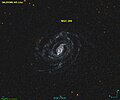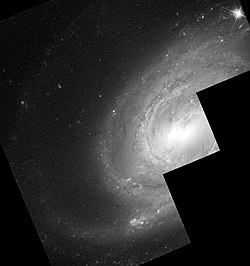NGC 289
| Galaxie NGC 289 | |
|---|---|
 | |
| Aufnahme mit dem Víctor M. Blanco Telescope von NGC 289 & LEDA 708504 (o.) | |
| AladinLite | |
| Sternbild | Bildhauer |
| Position Äquinoktium: J2000.0, Epoche: J2000.0 | |
| Rektaszension | 00h 52m 42,3s [1] |
| Deklination | −31° 12′ 21″ [1] |
| Erscheinungsbild | |
| Morphologischer Typ | SAB(rs)bc / AGN[1] |
| Helligkeit (visuell) | 10,9 mag[2] |
| Helligkeit (B-Band) | 11,7 mag[2] |
| Winkelausdehnung | 12′,0 × 7′,0[2] |
| Positionswinkel | 130°[2] |
| Flächenhelligkeit | 13,9 mag/arcmin²[2] |
| Physikalische Daten | |
| Zugehörigkeit | LDCE 33[1] |
| Rotverschiebung | 0,005434 ± 0,000007[1] |
| Radialgeschwindigkeit | (1629 ± 2) km/s[1] |
| Hubbledistanz H0 = 73 km/(s • Mpc) | (72 ± 5) · 106 Lj (22,0 ± 1,5) Mpc [1] |
| Durchmesser | 250.000 (+Spiralarmfragmente) Lj[3] |
| Geschichte | |
| Entdeckung | John Herschel |
| Entdeckungsdatum | 27. September 1834 |
| Katalogbezeichnungen | |
| NGC 289 • PGC 3089 • ESO 411-25 • MCG -05-03-010 • IRAS 00502-3128 • 2MASX J00524236-3112209 • AM 0050-312 • VV 484 • GC 163 • h 2355 • | |
NGC 289 ist eine leuchtschwache (LSBG) Balken-Spiralgalaxie mit aktivem Galaxienkern vom Hubble-Typ SBbc im Sternbild Bildhauer am Südsternhimmel. Sie ist schätzungsweise 72 Millionen Lichtjahre von der Milchstraße entfernt und hat einen Durchmesser von etwa 250.000 Lj.
Das Objekt wurde am 27. September 1834 von dem britischen Astronomen John Herschel entdeckt.[4]
- Hochaufgelöste Aufnahme mithilfe des Hubble-Weltraumteleskops
- Ultraviolettaufnahme mittels GALEX
Literatur
- König, Michael & Binnewies, Stefan (2019): Bildatlas der Galaxien: Die Astrophysik hinter den Astrofotografien, Stuttgart: Kosmos, S. 119
Weblinks
Einzelnachweise
Auf dieser Seite verwendete Medien
NGC 289 by HST
Autor/Urheber: Donald Pelletier, Lizenz: CC BY-SA 4.0
Image créée à l'aide du logiciel Aladin Sky Atlas du Centre de Données astronomiques de Strasbourg et des données publiques en format FIT de GALEX
Autor/Urheber: CTIO/NOIRLab/DOE/NSF/AURA Image processing: T.A. Rector (University of Alaska Anchorage/NSF’s NOIRLab), J. Miller (Gemini Observatory/NSF’s NOIRLab), & M. Zamani (NSF’s NOIRLab), Lizenz: CC BY 4.0
In the constellation Sculptor lies this large extended spiral galaxy called NGC 289. Despite being around 75 million light-years away, the light of NGC 289 is stunningly captured here by the Dark Energy Camera (DECam) on the Víctor M. Blanco 4-meter Telescope at Cerro Tololo Inter-American Observatory (CTIO), a Program of NSF’s NOIRLab. The galaxy’s bluish arms reach through the expanse of space over 100,000 light-years, larger than the size of our own Milky Way. It’s classified as a Type II Seyfert galaxy with its ripe collections of star formation and bright core, but it’s also relatively faint. Studies have found that the galaxy contains large amounts of dark matter, which is a common feature of all galaxies with a low surface brightness. Dark matter is yet to be directly observed, which led the US Department of Energy to build the DECam in order to study the nature of dark matter. Since the conclusion of its survey, DECam has been available to other scientists for use, such as for this image of NGC 289.




